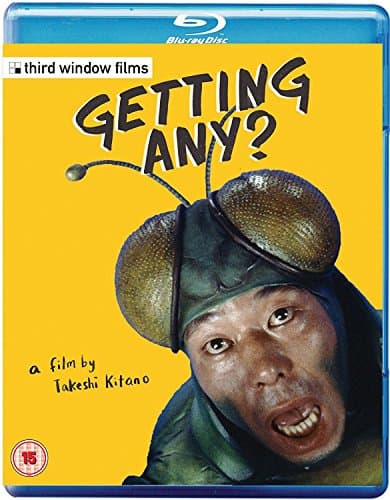It is something of a rule among comedians or for that matter, anyone who like to tell funny stories to never actually laugh about your own jokes. While the statement is debatable considering many successful actors and actresses starring in comedies laugh about theirs, making this principle the foundation of a feature film, is at the very least quite risky. However, after the bleak gangster drama that was “Sonatine”, director and comedian Takeshi Kitano decided to do just that with his next project, “Getting Any?”. Among the movies he had directed up to this point, this one was perhaps the least commercially successful and was largely ignored by international festivals and viewers, until UK Third Window released a Blu-ray of the film some years ago. Therefore, it is about time to re-discover this interesting, if somewhat flawed entry in Kitano's filmography, especially as it foreshadows his later features, such as “Takeshis” or “Glory to the Filmmaker!”.
Buy This Title
on Amazon

One of the few things in his life he cares about is finally having sex, which is why Asao (Dankan) invests all his time and money into making this happen. Relying on his imagination, films and ads, he always finds new ways he explores which might bring him closer to his ultimate goal of having intercourse. At the very beginning of the story, he dreams of buying a car after having seen a movie (?) about a couple having “car sex”, but his many attempts of actually acquiring an automobile are thwarted by his lack of money, his inexperience with cars and a mischievous car dealer. Despite the many setbacks and humiliations, Asao does not give up, and eventually decides on other means of having sex, flying first class (because sex, as he thinks, is part of the on-board service) and also becoming an actor.

Finally, after a run-in with the local yakuza, while trying to be a hitman for the mob, he seeks the help of an inventor (Takeshi Kitano) and his assistant. The scientist eventually wins the young man as a guinea pig for his experiment of making humans invisible, which Asao wants to abuse, sneaking into girls' locker rooms. However, the final experiment has terrifying consequences, resulting in a nationwide panic.
As with many filmmakers and their projects, Kitano is no exception when it comes to discussing the inspirations or meaning of his work. While the idea behind “Getting Any?”, according to its director, was to make fun of his own jokes and how especially men of his generation had trouble talking about sexuality, there are far more layers which you can see in the story, its characters and its aesthetics. Indeed, its structure, which combines various sketches and gags, is similar to a Monty Python feature, since its narrative framework, a guy wanting to get laid, is a rather simple connector of the various sequences. At the same time, sexuality, as well as status and fame can be seen as the driving force of Asao's actions, who is heavily influenced by the amount of media he consumes, if the opening shot of his room is any indicator. In the end, the question posed in the title of the movie, its provocative nature, may also hint at sexuality or the pretense of “getting any” serves as an inclusion into society, at least in the eyes of Asao.
Additionally, the use of a meta-narrative combined with a fitting structure has always been at the very heart of Kitano's humor. Various influences from global Japanese and global pop culture define the segments, ranging from Ivan Reitman's “Ghostbusters”, Michael Jackson's music video to “Beat It” as well as the “Zatoichi”-films and the yakuza-genre. “Getting Any?” blend all of these texts together in an entertaining, sometimes quite confusing and silly mixture, whose absurdity should not be taken seriously. Indeed, Kitano seems to pose the question whether there is actually anything behind all of these texts, something concrete and feasible, which may be just as laughable a task as Asao's quest for having sex.
Similar to the collaboration in “Boiling Point” Dankan's performance and dead pan-delivery is the key to making the jokes as well as the subtexts work, as Asao is on the one hand a consumer, as mentioned before, but on the other hand, also a conduit for all these influences.
In conclusion, “Getting Any?” is an entertaining, meta-comedy. Takeshi Kitano's feature is at times confusing and just as fast-paced as his own brand of comedy (when he was still on stage performing as part of the Two Beats), but it is a feature which is worth exploring further as it includes interesting, clever comments about pop culture and Japanese society.















